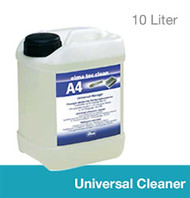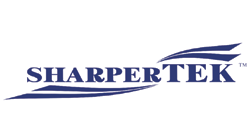Selecting the Best Ultrasonic Cleaning Solution
The correct ultrasonic cleaner solution is as important to your cleaning operation as the ultrasonic cleaning equipment you use. Equipment and solution decisions can be made in parallel with the knowledge that the ultrasonic cleaner you use does not restrict the ultrasonic cleaner solution you use. The choices are based on what you are cleaning, and the type of contaminants being removed.
Ultrasonic Cleaner Solutions Defined
Most ultrasonic cleaner solutions (also called soaps or detergents) in use today are in the form of biodegradable concentrates - although some may be used full strength. Manufacturers provide detailed instructions on their use, including dilution, recommended cleaning temperatures, and also what are called material safety data sheets (MSDS) that detail chemistry, handling and disposal procedures.
This information is important in your cleaning solution selection to achieve satisfactory results. You'll find several examples in our post directed to hobbyists and collectors.
Here are some others:
- Remove rust and other contaminants from costly tools
- Operate barber and hairstyling salons
- Clean fuel injectors, carburetors and other engine components
- Operate a lawn mower and small engine repair shop
This guide helps you make the selection based on your cleaning challenges. It describes the various types of cleaning solutions and provides examples of where they can be employed.
Types of Ultrasonic Cleaner Solutions
In general, ultrasonic cleaner solutions can be broadly classified in two ways: by pH or as emulsifying or demulsifying formulations.
pH Described
The pH designation helps classify the formula as acidic, alkaline, or neutral with high pH values associated with alkaline and lower as acidic.
By way of further explanation pH is a measure of hydrogen ion concentration. Aqueous ultrasonic cleaner solutions at 25°C with a pH below 7 are acidic; those with a pH greater than 7 are alkaline (sometimes referred to as basic). A pH of 7 designates neutral.
Emulsifying and Demulsifying Described
An emulsifying ultrasonic cleaner solution formulation keeps contaminants in suspension where they accumulate and begin to lower cleaning effectiveness.
These contaminants may also adhere to the product when it is removed from the cleaning tank, possibly necessitating a rinsing operation. When cleaning efficiency drops to unacceptable levels the solution should be drained and replaced with a fresh batch.
These formulations are typically used for low-volume cleaning operations.
Demulsifying ultrasonic cleaner solutions allow contaminants to float to the surface where they can be skimmed off and set aside for later disposal.
Industrial ultrasonic cleaners may be equipped with sprays and weirs to direct floating impurities into a collection vessel. But as with emulsifying formulas cleaning efficiency will drop off with continued use, necessitating solution replacement.
Demulsifying formulations are typically used in high-volume cleaning operations.
Note that if strong acids are used the stainless-steel tank must be protected by using an acid-resistant plastic insert. The tank itself contains tap water and a surfactant. Sonic energy penetrates the plastic and acts on parts immersed in the acidic solution for cleaning.
Examples of these formulations are provided below.
Key Selection Criteria For Ultrasonic Cleaner Solutions
- What is being cleaned
- The contaminants to be removed
- The product configuration
- What the product is made of
- Post-cleaning requirements if any
There can be other cleaning solution selection criteria but these will do for the purpose of this post. Here are some examples of these formulations and their uses.
Examples of Ultrasonic Cleaner Solutions and Uses
Alkaline Ultrasonic Cleaning Solutions
Alkaline (a.k.a. caustic) cleaning solutions are exemplified by the elma tec clean A series of concentrates. Of these we bill slightly demulsifying elma tec clean A4 as a nearly universally applicable concentrate for just about every need in the lab and workshop.
Diluted to 2 to 5 % with water and operated at a bath temperature of 50⁰C to 80⁰C it’s great for glass, ceramics, plastics, rubber, and most metals except the lighter alloys.
We recommend elma tec clean A4 to clean carburetors, fuel injectors, engine parts, newly machined parts, and similar components to remove smoke, grease, soot, wax, coolant oils, loose metal particles and dust.
For a milder version select emulsifying elma tec clean A1 ultrasonic cleaning solution for glass, optical assemblies, ceramic substrates, and electronics. We recommend it for cleaning printed circuit boards used in PDAs and similar devices. It safely removes soldering flux, oil, dust, water damage, coffee, tea, soft drinks, milk, and fingerprints when diluted to 3 to 10% with water and operated at 40⁰C to 80⁰C (65⁰C for PCBs).
Another version, ammonia-containing mildly alkaline, emulsifying elma tec A2 is a good selection to remove oil, fat, grease, sweat, oxides, polishing compounds and similar contaminants from ferrous metals and non-ferrous brass, copper, bronze, precious metals and jewelry when diluted to 3% to 5%. Its ammonia content makes it especially useful for brightening brass and copper.
Acidic Ultrasonic Cleaning Solutions
Acidic ultrasonic cleaning concentrates are used for tough cleaning jobs and can involve a chemical reaction to remove contaminants. Emulsifying elma tec clean S1 diluted to 1 to 5% removes oxide films, rust, lime, grease, oil, corrosion, and mineral deposits from nonferrous heavy metals, stainless steel, aluminum, light metals, brass, steel, plastics and glass.
Stronger acidic solutions are available for these materials along with steel, iron, gray cast iron, hard alloys, nickel, nonferrous heavy metals and precious metals. Remember to remove steel products immediately after de-rusting and rinse with an anticorrosive. Ask us about elma-KS for temporary corrosion protection during cleaning and rinsing cycles.
Neutral Ultrasonic Cleaning Solutions
Elma tec clean N1 is phosphate-free emulsifying neutral cleaning concentrate for gentle cleaning action. It is used for the treatment of highly sensitive pieces to remove oil, grease and other organic particles.
While it is safe for all metals, plastics, ceramics, glass, and rubber it should be tested before using on magnesium. When used in an ultrasonic cleaner it is diluted to 2 to 5% with water. Without ultrasound dilute it to 10%. Contact iUltrasonic for more information on elma tec clean N1.
Special Purpose Ultrasonic Cleaner Solutions
As indicated above a variety of special formulations are available for specialized cleaning. Here are some examples:
Cleaning Medical and Surgical Instruments
There are strong governmental and professional association recommendations/requirements for cleaning medical and surgical instruments including cleaning and disinfecting or sterilizing.
UltraDose Germicidal Hospital Grade Concentrate has demonstrated effectiveness against viruses similar to COVID-19 Coronavirus on hard, non-porous surfaces and can be used against COVID-19 Coronavirus in accordance with directions.
Enzymatic concentrate MedClean C7 is used to clean medical and surgical instruments by removing blood, tissue, ointments, light oils and similar contaminants before disinfecting or sterilizing.
Cleaning Firearms
Ultrasonic cleaner solutions help public safety and military organizations, hunting and skeet shooting clubs as well as firearm collectors maintain performance of their pistols and rifles with regular sessions in an ultrasonic cleaner for firearms.
Two formulations available for firearm maintenance are GunClean L6 to remove powder residue, bullet shavings, hardened lubricants and other contaminants much faster and more thoroughly than using brushes or solvents.
After cleaning the firearm can be fully lubricated in a bath of GunLube L5 ultrasonic gun lubricant for protection against rusting.
Ultrasonic Cleaning Solutions for Jewelry
Removing dirt, grease, buffing compounds, rouge, tripoli and oxides from silver, platinum, jewelry and gems is accomplished by a bath in JewelryClean S8. But note that softer jewels such as pearls should not be cleaned ultrasonically.
Check our website for other examples of ultrasonic cleaning solutions from iUltrasonic.
A Caution on Flammable Ultrasonic Cleaning Solvents
Large-scale cleaning with flammable solvents requires explosion-proof ultrasonic cleaning equipment to avoid the danger of fire or explosions. It also requires that the location of the equipment and its operating procedures conform to national and local regulations.
On a smaller scale, however, and with special precautions benchtop kits can be used to clean small parts. These are submerged in a beaker containing the solvent. The beaker is lightly covered and placed into the ultrasonic tank filled with water and a surfactant.
Cavitation will occur outside and inside of the beaker, but the solvent will not be in direct contact with the tank of the ultrasonic cleaning equipment.
Even with these precautions the ultrasonic cleaner should be located near or under an exhaust vent. Contact your local regulatory authorities or our experts for advice on cleaning with volatile solvents.
If your operations require large scale cleaning with volatile solvents such as IPA, acetone or toluene contact us for information on the SOL-XP explosion proof ultrasonic cleaner along with information on how to comply with NFPA and related codes concerning hazardous areas.
Tips on Maintaining Ultrasonic Cleaner Solutions
As noted earlier in this post, contaminants removed during the cleaning process remain in the cleaning solution and eventually reduce performance.
While performance can be extended by the means suggested eventually the solution must be changed. Drain and dispose of it along with skimmed off contaminants according to local regulations.
At this time take the time to clean the tank following the user manual. Then fill and degas fresh solution to continue your cleaning operations.
Contact Us for Cleaning Solution Advice
This post touches on some of the major considerations involved in selecting and using ultrasonic cleaning solutions. We are available for more detailed advice that will help you select the correct cleaning equipment, cleaning solution(s) and operating procedures to maximize the efficiency of your operations.








